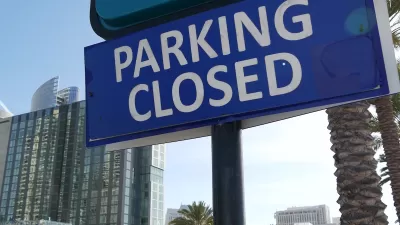Cities around the world are finding ways to go on a parking diet, freeing up unused space. San Francisco and Philadelphia are two U.S. leaders, while cities like Paris, Copenhagen, and Zurich pursue even more aggressive measures.

Though it's necessary in cities designed around the car, the way most cities provide for parking is hardly efficient. "'As parking regulations were put into zoning codes, most of the downtowns in many cities were just completely decimated,' says Michael Kodransky, global research manager for the Institute of Transportation and Development Policy. “What the cities got, in effect, was great parking. But nobody goes to a city because it has great parking.'"
The first step toward addressing the problem is simply measuring it. From Nate Berg's article: "Knowing the parking inventory has made it easier for the city to pursue public space improvements such as adding bike lanes or parklets, using the data to quell inevitable neighbourhood concerns about parking loss."
Invoking UCLA parking guru Donald Shoup, Berg writes, "After San Francisco implemented a pilot project with real-time data on parking availability and dynamic pricing for spaces, an evaluation found that the amount of time people spent looking for parking fell by 43%." Philadelphia's efforts to inventory parking have also led to space gains.
Outside the U.S., many cities have undertaken more aggressive strategies. "In 1996, [Zurich, Switzerland] decreed that there would be no more parking: officials placed a cap on the amount of parking spaces that would exist there, putting in place a trading system by which any developer proposing new parking spaces would be required to remove that many parking spaces from the city's streets."
Since 2003, Paris eliminated roughly 15,000 above-ground parking spaces. "São Paulo, for instance, got rid of its minimum parking requirements and implemented a maximum that could be built into specific projects. Beijing, Shenzhen and Guangzhou are hoping to emulate San Francisco's dynamic pricing approach."
FULL STORY: Lots to lose: how cities around the world are eliminating car parks

Alabama: Trump Terminates Settlements for Black Communities Harmed By Raw Sewage
Trump deemed the landmark civil rights agreement “illegal DEI and environmental justice policy.”

Study: Maui’s Plan to Convert Vacation Rentals to Long-Term Housing Could Cause Nearly $1 Billion Economic Loss
The plan would reduce visitor accommodation by 25% resulting in 1,900 jobs lost.

Why Should We Subsidize Public Transportation?
Many public transit agencies face financial stress due to rising costs, declining fare revenue, and declining subsidies. Transit advocates must provide a strong business case for increasing public transit funding.

Paris Bike Boom Leads to Steep Drop in Air Pollution
The French city’s air quality has improved dramatically in the past 20 years, coinciding with a growth in cycling.

Why Housing Costs More to Build in California Than in Texas
Hard costs like labor and materials combined with ‘soft’ costs such as permitting make building in the San Francisco Bay Area almost three times as costly as in Texas cities.

San Diego County Sees a Rise in Urban Coyotes
San Diego County experiences a rise in urban coyotes, as sightings become prevalent throughout its urban neighbourhoods and surrounding areas.
Urban Design for Planners 1: Software Tools
This six-course series explores essential urban design concepts using open source software and equips planners with the tools they need to participate fully in the urban design process.
Planning for Universal Design
Learn the tools for implementing Universal Design in planning regulations.
Smith Gee Studio
Alamo Area Metropolitan Planning Organization
City of Santa Clarita
Institute for Housing and Urban Development Studies (IHS)
City of Grandview
Harvard GSD Executive Education
Toledo-Lucas County Plan Commissions
Salt Lake City
NYU Wagner Graduate School of Public Service





























